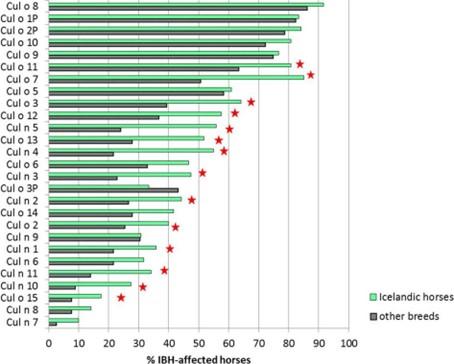Allergens
Numerous allergen genes, originated in the salivary glands of three Culicoides species have been isolated and the proteins expressed in E. coli (Langer et al., 2009, Schaffartzik et al., 2010 and 2011; van der Meide et al., 2013, Peeters et al., 2013) Several of the allergens have also been expressed in insect cells (Stefánsdóttir 2015, Kristínarson 2017, Guðnadóttir 2021) and six in barley. The major causative allergens have recently been mapped using a protein chip microarray containing a comprehensive panel of available Culicoides spp. allergens (Novotny et al., 2021). The horses become sensitized simultaneously to multiple Culicoides r-allergens (Birras et al., 2021).
Image caption: Comparison of the IgE levels to the 27 recombinant Culicoides allergens between IBH-affected horses from the Icelandic breed (n=120) versus horses belonging to other breeds (n=79) within the horse group from Switzerland. Significant differences between groups in the Fisher’s exact test are shown with a star Schematic figure from Novotny et al., 2021.
IBH can affect all breeds of horses, but Icelandic horses born in Iceland and exported to the continent are more strongly affected than most other breeds (Bjornsdottir et al., 2006, Torsteinsdóttir et al. 2018). They also seem to be sensitized to more allergens than horses born in Europe (Novotny et al., 2021).
Details of references in the text above.
